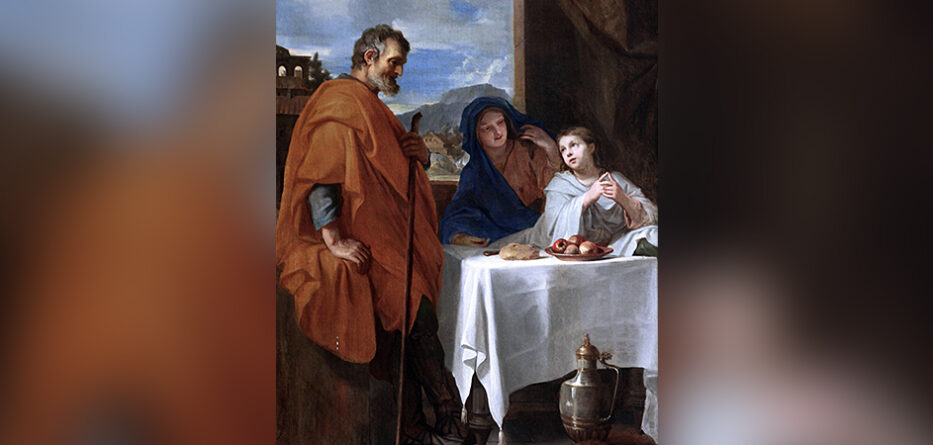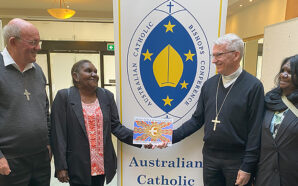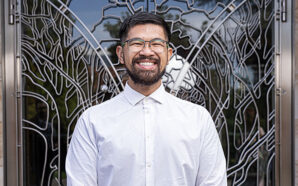The Feast of The Holy Family of Jesus, Mary and Joseph
Readings: Genesis 15:1-6, 21:1-3; Psalm 1-4(105):1-6, 8-9; Hebrews 11:8, 11-12, 17-19; Luke 2:22-40
31 December 2023
“The Lord remembers his covenant forever.” – Psalm 105:8
The importance of today’s feast is indicated by the fact that the Church chooses the first Sunday after Christmas—the birth of Jesus himself into a human family to celebrate it. While we live in a time of unprecedented confusion where the family is under attack to change its fundamental meaning and structure, it remains the foundation of society, and the most stabilising force of human civilisation and culture. At the heart of the family, and its unifying force, is faith, hope and love.
The environment in which we grow as children determines the people we will become as adults. Even Jesus, in his humanity, was not exempt from this. He became a carpenter like his foster-father, and we can be sure that he took on many characteristics of both him and Mary as an adult. Like any family, they would have experienced the joys and happiness of family life, but also the sorrows and sufferings. True love is measured not by emotions or sentiments, but by our willingness to endure and persevere, to be faithful and steadfast, not just in the good times, but especially the difficult times. Faith, hope and love.
Today’s feast gives us the opportunity to reflect upon the fundamental aspects of family life and how we try to practise them in our own families. Of no less importance is how we try to live them out in the wider family to which we belong—the family of God—where the bond of Faith endures even beyond the boundaries of this earthly life to eternal life. Since it is true of the human family, it is equally true of the family of God—the Church.
May the Holy Family of Nazareth: Jesus, Mary and Joseph, intercede for us today as we strive to live as they have taught and shown us in faith, hope and love. Amen.
Fr Christopher G. Sarkis
Artist Spotlight
The Holy Family before the return from Egypt (or The Grace) – Charles le Brun (1619 – 1690)
The Holy Family before the return from Egypt (or The Grace) (c. 1655–1656). Oil on canvas, 138cm × 89cm.Louvre Museum, France. Public Domain.
“The Church has always had the duty of scrutinising the signs of the times and of interpreting them in the light of the Gospel,” declared Vatican II (Gaudium et spes, 4). The Gospel offers mankind a sign from beyond time. Today there are so many signs, that interpreting them all can become very confusing. Nowhere is this more evident than in the modern family.
New reproductive technologies are being developed; public opinion is shifting about the origin, nature and purpose of the family; new laws are every day being passed. Does the Gospel have anything to say?
Firstly, the Gospel teaches that God, too, institutes signs. Jesus, himself, teaches that the Incarnation is a sign when he says to Philip: “He who has seen me has seen the Father” (Jn 14:9). And that he might always be with us, Jesus gave to the Church the seven sacraments as signs of God’s grace. These signs point beyond ordinary human life to a higher life. “If you do not believe me when I speak to you about earthly things, how will you believe me when I speak to you about heavenly things?” said Jesus to Nicodemus (Jn 3:12). In other words, heavenly life is given to us entirely through earthly signs. We must understand this, because we have no alternative.
When we consider the principal mysteries of our faith, we find they are expressed in terms of relationships within the human family. God is Father who has an eternally begotten Son. The relationship of this Son to his Church is that of a bridegroom to his bride. The love of God for his people is like that of a mother for her infant child. And among the seven sacraments, the best known is the sacrament of Matrimony. It is the best known because it is the closest to nature—a boundary, as it were, between the natural and supernatural order; the natural beginning point by which we enter the life of grace. Thus, it was the first sacred sign instituted by God at the origin of our race in paradise when he united Adam and Eve in marriage.
Almost at the beginning of his Gospel, St John relates that it was at a wedding feast that Jesus first manifested his glory and his disciples first began to believe in him. This, surely, was not by chance. The natural beginning of the Christian faith is in the Christian family, and the first sacrament by which children come to believe is the marriage between their parents. Children first come to believe in Christ’s love for them, and they first become disciples, through the marriage of their parents, and thus Christ is glorified.
At the beginning of creation, God blessed each day and declared it good. But on one occasion, it was not good—the man was alone. With the creation of woman, it was very good. From all eternity, God understood himself as the Son of Mary, a member of the human family. The family, then, reflects God’s goodness and beauty. Hence, we cannot know God, we cannot love God, without knowing and loving the human family.
Modern distortions of the family can lead to distortions in faith. The indissolubility of marriage, for example, is intended to be a sign of God’s eternal and unique love for his Church. And in households where, by design, there is no father or there is no mother, children may find it difficult to understand God as Father or what it means for God to love us as a mother. Relationships within a family are not just functions. The case of the Holy Family is a striking example.
If ever a father and husband were unnecessary and expendable in a family from the perspective of a functionality, it was in the Holy Family. St Joseph was not necessary to beget or even educate the Child. God was the Child’s Father, and the Holy Spirit was the Spouse of the Virgin. St Joseph was not necessary as a moral or intellectual guide to his spouse whom the Church acclaims as Seat of Wisdom. Angelic protection could have sufficed to provide for and protect the Child and his mother. Yet, in spite of all this, God willed the Holy Family to have a husband and father, and it was through St Joseph that he guided the Holy Family in the early years of the life of Jesus. In the one case where God could have done without a husband and father, he chose not to—a good example of how grace builds upon, and protects, nature.
Charles Le Brun, born 1619, became the court painter to Louis XIV who declared him: “The greatest French artist of all time.” At the age of 15, he was already receiving commissions from Cardinal Richelieu.
He paints the Holy Family at their last meal in Egypt before they set out to return to Nazareth, evidenced by the age of Christ who appears to be about seven years old.
St Joseph is obviously the dominant figure in the painting, which was commissioned for a brotherhood of master carpenters. He leans on a large stick, for he is ready for the imminent departure. His carpenter’s tools form the still life in the foreground. But Le Brun has added several powerful symbols. The dish of apples evokes mankind’s original sin; the loaf of bread on the table and the wine jug at the base designate the Eucharist; the triangular table, the Trinity. Jesus’ white garments are an allusion to his future transfiguration.
But while Joseph dominates the scene physically, all attention, both from Mary and himself, is on the Child whose hand gesture is that of a medieval “master” or teacher. He is explaining the mysteries contained in the painting’s symbols.
The painting has sometimes been called The Grace or The Benediction. As head of the household, Joseph is about to ask God’s blessing on the coming meal.
Monsignor Graham Schmitzer
Fr Christopher G Sarkis is the parish priest of Our Lady Help of Christians Parish in Rosemeadow, in the Diocese of Wollongong, NSW. He was ordained in 1985 and has served in a number of parishes in the diocese. His current diocesan appointments include the College of Consultors, Council of Priests, and Clergy Remuneration Fund.
Monsignor Graham Schmitzer is the retired parish priest of Immaculate Conception Parish in Unanderra, NSW. He was ordained in 1969 and has served in many parishes in the Diocese of Wollongong. He was also chancellor and secretary to Bishop William Murray for 13 years. He grew up in Port Macquarie and was educated by the Sisters of St Joseph of Lochinvar. For two years he worked for the Department of Attorney General and Justice before entering St Columba’s College, Springwood, in 1962. Mgr Graham loves travelling and has visited many of the major art galleries in Europe.
With thanks to the Diocese of Wollongong, who have supplied this reflection from their publication, The Sign: Advent and Christmas Reflections 2023. Reproduced with permission.








